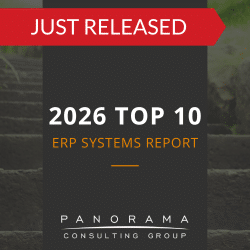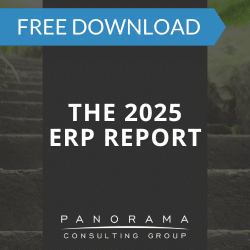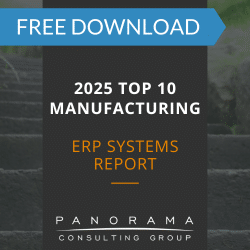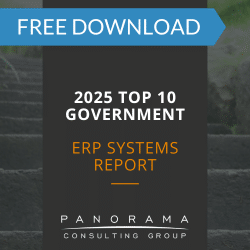- Generative AI tools often sound confident—even when their answers lack accuracy or context.
- Overconfident enterprise AI can mislead ERP selection, supply chain planning, and contract risk analysis.
- GenAI forecasting hallucinations and enterprise AI hallucinations distort strategy by masking uncertainty.
- Leaders should apply generative AI risk management practices and validate outputs with expert oversight.
Great idea . . . Absolutely . . . I can help with that!
Sound familiar? This isn’t a conversation with your company’s ‘yes man;’ it’s a conversation with your enterprise AI chatbot.
If you’ve spent any amount of time using generative AI tools like ChatGPT, you know that almost every response starts with one of these confident phrases.
Unfortunately, in enterprise use cases, like supply chain planning and financial forecasting, this performative certainty creates risk. When a generative AI tool is unaware of its blind spots, it produces confident answers built on flawed assumptions, while offering no indications that something might be missing.
Overconfident Enterprise AI: Where Precision Sounds Real but Isn’t
An illusion of reliability is dangerous, especially in enterprise settings involving multimillion-dollar investments or operational overhaul.
Here are three ways overconfident enterprise AI can shape decisions in misleading ways:
1. Forecasting and Planning Misfires
Ask an enterprise AI assistant to forecast demand across your supply chain system and you’ll receive detailed output backed by rationale. However, what might remain unstated is that the tool lacked access to current supplier lead times, regional labor disruptions, or in-transit delays.
These blind spots lead to GenAI forecasting hallucinations—numerical outputs disconnected from real operational dynamics. Acting on these figures without validation can create downstream disruption.
2. Misleading ERP System Recommendations
Executives frequently prompt GenAI to generate a list of software systems that fit their business model. The AI responds immediately with vendor names and features. However, it compiles this based on surface-level content, rather than implementation-specific intelligence.
During ERP selection, AI hallucinations can eliminate viable options before evaluation even begins. In sectors like process manufacturing or regulated distribution, this often results in overlooked compliance features and missed integration requirements.
3. Superficial Risk Guidance
AI tools now assist with vendor contract reviews, highlighting terms and flagging risks. While helpful in theory, this process often lacks context.
For example, AI might call out boilerplate language while missing license caps, audit triggers, or usage-based billing terms that a business software consultant would quickly catch.
When an AI-generated contract summary confidently flags basic red flags, such as missing SLAs or vague termination clauses, it gives the impression that the review is complete. This perceived thoroughness can cause teams to skip legal escalation and deeper review.
How to Leverage AI Without Letting It Think for You
Generative AI offers real utility, but it should remain a support function—never a replacement for critical enterprise judgment. ERP selection and supply chain optimization demand governance and human oversight.
Here are three practical ways to counteract AI’s confidence problem:
1. Always Pair AI With Human Expertise
Use AI to surface themes and draft models; then validate those insights with your company’s subject matter experts.
Whether you’re asking AI to explore providers of ERP implementation services or rethink the customer experience, every AI-generated output should pass through a lens of internal knowledge and domain expertise. Bring in cross-functional leaders—such as finance strategists, operational leads, and legal counsel—to review what the AI overlooked or misframed and ensure alignment with business context, regulatory requirements, and strategic priorities.
2. Build AI Risk Management Into Governance Structures
Generative AI risk management requires shared ownership across operations, finance, and technology. Set policies that define acceptable use cases, review procedures, and escalation thresholds for AI-generated outputs.
If your organization conducts regular digital audits or ERP system reviews, incorporate GenAI checkpoints directly into those cycles. Investigate which data sources are being used, whether the information is current, and whether critical business context is being factored in.
3. Vet Strategic Outputs Before Acting on Them
AI may propose a shortlist, a roadmap, or a risk matrix. Before accepting any of it, interrogate the foundation. Compare it against contracts, stakeholder priorities, vendor data, and past implementation experiences.
For high-stakes decisions—such as selecting manufacturing software systems—AI can offer initial input, but project teams must retain final authority.
4. Improve the Design of the AI Itself
Enterprise AI use case design shouldn’t stop at deciding when or where to use AI—it should also define how the tool functions under real business conditions.
This includes:
- Fine-tuning models on enterprise-specific data
- Enabling retrieval from approved internal sources
- Exposing confidence levels or data gaps to users
These steps increase the reliability of AI-generated outputs by aligning the tool’s behavior with your actual decision environment.
Learn More About Generative AI in ERP Strategy
Generative AI speaks with confidence, but less frequently with caution. Its outputs enter boardrooms sounding verified—shaping ERP implementations and budget models with a tone that masks uncertainty.
If your organization is evaluating how to implement AI within ERP or enterprise workflows, our AI Readiness & Enablement Service Offering provides structured readiness assessments and enablement strategies to maximize value while managing risk.
Engage one of our ERP software consultants to define where AI creates value, where it needs boundaries, and where your people remain the final filter.















